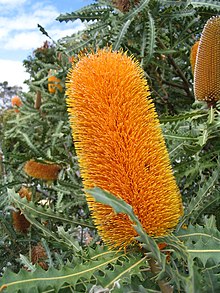Banksia ashbyi Contents Description Taxonomy Ecology Cultivation References External links Navigation menu10.1111/j.1365-2486.2008.01559.x"Banksia ashbyi""Banksia ashbyi"106454286571717994614571237516457143349703064-1894932188587kew-2669019BAAS5urn:lsid:ipni.org:names:703064-150205574expanding iteexpanding ite
Banksia taxa by scientific nameEudicots of Western AustraliaEndemic flora of Western AustraliaPlants described in 1934Banksia stubsWestern Australian plant stubs
plantgenusheathspinifexWestern AustraliaGeraldtonExmouthhabitclimate changegerminate
| Ashby's Banksia | |
|---|---|
 | |
Scientific classification | |
| Kingdom: | Plantae |
| (unranked): | Angiosperms |
| (unranked): | Eudicots |
| Order: | Proteales |
| Family: | Proteaceae |
| Genus: | Banksia |
| Species: | B. ashbyi |
Binomial name | |
Banksia ashbyi Baker f. | |
| Subspecies | |
| |
The Ashby's Banksia (Banksia ashbyi) is a species of shrub in the plant genus Banksia. It occurs in heath and spinifex country along the coast of Western Australia between Geraldton and Exmouth.
Contents
1 Description
2 Taxonomy
3 Ecology
4 Cultivation
5 References
6 External links
Description
This shrub grows up to 4 m high and 2 m wide, lobed leaves grow to 150 mm in length. The flower spikes are orange in colour, growing 150 mm high and 90 mm wide. B. ashbyi flowers from September to November.
Taxonomy
There are two subspecies, distinguished by habit:
B. ashbyi subsp. ashbyi grows as a tree up to 7 m in height. It lacks a lignotuber, so is fire-sensitive.
B. ashbyi subsp. boreoscaia grows as a sprawling shrub no more than 2 m high. It is lignotuberous, so fire-tolerant.
Ecology
An assessment of the potential impact of climate change on this species found that its range is unlikely to contract and may actually grow, depending on how effectively it migrates into newly habitable areas.[1]
Cultivation
Seeds do not require any treatment, and take 16 to 61 days to germinate.[2]
References
^ Fitzpatrick, Matthew C.; Gove, Aaron D.; Sanders, Nathan J.; Dunn, Robert R. (2008). "Climate change, plant migration, and range collapse in a global biodiversity hotspot: the Banksia (Proteaceae) of Western Australia". Global Change Biology. 14 (6): 1–16. doi:10.1111/j.1365-2486.2008.01559.x..mw-parser-output cite.citationfont-style:inherit.mw-parser-output .citation qquotes:"""""""'""'".mw-parser-output .citation .cs1-lock-free abackground:url("//upload.wikimedia.org/wikipedia/commons/thumb/6/65/Lock-green.svg/9px-Lock-green.svg.png")no-repeat;background-position:right .1em center.mw-parser-output .citation .cs1-lock-limited a,.mw-parser-output .citation .cs1-lock-registration abackground:url("//upload.wikimedia.org/wikipedia/commons/thumb/d/d6/Lock-gray-alt-2.svg/9px-Lock-gray-alt-2.svg.png")no-repeat;background-position:right .1em center.mw-parser-output .citation .cs1-lock-subscription abackground:url("//upload.wikimedia.org/wikipedia/commons/thumb/a/aa/Lock-red-alt-2.svg/9px-Lock-red-alt-2.svg.png")no-repeat;background-position:right .1em center.mw-parser-output .cs1-subscription,.mw-parser-output .cs1-registrationcolor:#555.mw-parser-output .cs1-subscription span,.mw-parser-output .cs1-registration spanborder-bottom:1px dotted;cursor:help.mw-parser-output .cs1-ws-icon abackground:url("//upload.wikimedia.org/wikipedia/commons/thumb/4/4c/Wikisource-logo.svg/12px-Wikisource-logo.svg.png")no-repeat;background-position:right .1em center.mw-parser-output code.cs1-codecolor:inherit;background:inherit;border:inherit;padding:inherit.mw-parser-output .cs1-hidden-errordisplay:none;font-size:100%.mw-parser-output .cs1-visible-errorfont-size:100%.mw-parser-output .cs1-maintdisplay:none;color:#33aa33;margin-left:0.3em.mw-parser-output .cs1-subscription,.mw-parser-output .cs1-registration,.mw-parser-output .cs1-formatfont-size:95%.mw-parser-output .cs1-kern-left,.mw-parser-output .cs1-kern-wl-leftpadding-left:0.2em.mw-parser-output .cs1-kern-right,.mw-parser-output .cs1-kern-wl-rightpadding-right:0.2em
^ Sweedman, Luke; Merritt, David (2006). Australian Seeds: a Guide to Their Collection, Identification and Biology. Collingwood, Victoria: CSIRO Publishing. p. 202. ISBN 0-643-09298-6.
George, Alex S. (1981). "The Genus Banksia L.f. (Proteaceae)". Nuytsia. 3 (3): 239–473.
George, Alex (1999). Wilson, Annette (ed.). Flora of Australia. 17B: Proteaceae 3: Hakea to Dryandra. CSIRO Publishing / Australian Biological Resources Study. pp. 175–251. ISBN 0-643-06454-0.
Taylor, Anne; Hopper, Stephen (1988). The Banksia Atlas (Australian Flora and Fauna Series Number 8). Canberra: Australian Government Publishing Service. ISBN 0-644-07124-9.
Bodkin, Frances (1986). Encyclopedia Botanica. North Ryde, NSW, Australia: Angus & Robertson. ISBN 0-207-15064-8.
External links
| Wikimedia Commons has media related to Banksia ashbyi. |
Wikispecies has information related to Banksia ashbyi |
"Banksia ashbyi". Flora of Australia Online. Department of the Environment and Heritage, Australian Government.
"Banksia ashbyi". FloraBase. Western Australian Government Department of Parks and Wildlife.
This Banksia-related article is a stub. You can help Wikipedia by expanding it. |
This Western Australian plant article is a stub. You can help Wikipedia by expanding it. |
Banksia stubs, Banksia taxa by scientific name, Endemic flora of Western Australia, Eudicots of Western Australia, Plants described in 1934, Western Australian plant stubsUncategorized